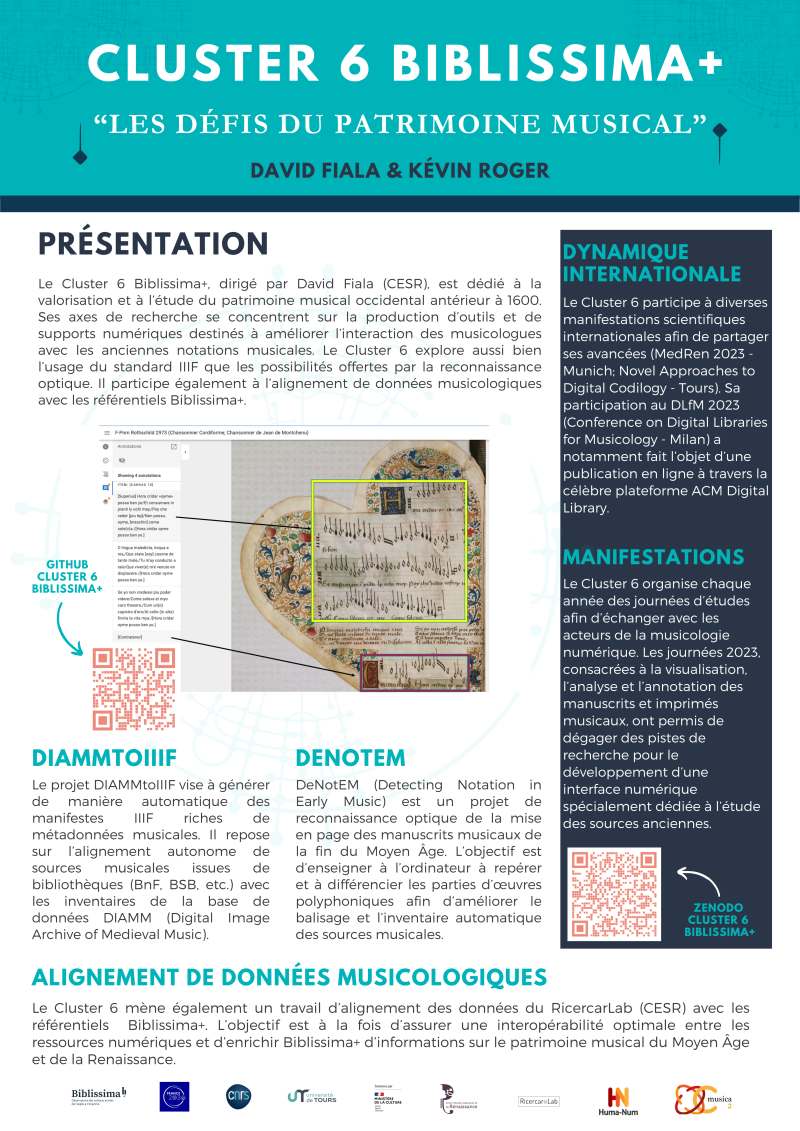

1/ Mapping Musical Heritage and Interoperability of Digital Resources
Several digital resources contribute to the study and promotion of the musical heritage of the Middle Ages and Renaissance. However, this landscape is largely heterogeneous regarding technology, data types and accessibility. Biblissima+ Cluster 6 has therefore set itself the task of developing digital solutions to improve consultation of early musical sources. The aim is to use tools that are capable of aggregating, cross-referencing and bringing together digitisation and metadata. A mapping of resources has enabled Cluster 6 to identify various needs and to build ‘bridges’ between systems.
DIAMMtoIIIF
The DIAMMtoIIIF project developed within the framework of Cluster 6 is a Python program designed to produce IIIF (International Image Interoperability Framework) manifests from the API of the DIAMM (Digital Image Archive of Medieval Music) database and the servers of several libraries such as the BnF and the Bayerische Staatsbibliothek. This project aims to increase the availability and interoperability of medieval music sources by simplifying their consultation and manipulation in a variety of digital contexts.
The contribution of this project lies in its ability to facilitate access to early musical scores while improving data interaction. By generating manifests, DIAMMtoIIIF makes it possible to standardise and unify the presentation of sources, thus enhancing their visibility and use in studies, while guaranteeing better preservation of the musical heritage. It also contributes to the development of IIIF in the musicological field.
Ricercar and Biblissima+ Data Alignment
The RicercarLab musicology program (CESR) has developed digital tools for visualising and exploiting corpora and reconstructing sound spaces. It has built up a very rich documentary collection covering the written musical heritage of the Middle Ages and Renaissance, excluding the immense corpus of Christian monodic liturgical chant. As part of the overhaul of its databases, RicercarLab has established data models for the description of sources and musical works that take into account their specific characteristics. Alignment with the Biblissima+ repositories is currently underway and will ultimately increase the amount of musical and musicological data available on the Bibilissima+ portal.
2/ Encoding and Digital Preservation of Early Works
As part of its activities to preserve musical heritage, Cluster 6 is also focusing on the encoding of early works through the MEI (Music Encoding Initiative). The main aim is to enable standardised digital representation of musical scores, and to ensure their integrity once published and shared. The format paves the way for more detailed analysis of works, while guaranteeing the digital preservation of their carriers. By collaborating with the Musica2 consortium in digital musicology (Huma-Num IR*), Cluster 6 is seeking to extend the capabilities of the MEI language so that it can support early notations, often ignored by traditional formats. A first project, SubtiliorEditor, focuses on certain sophisticated notations from the Late Middle Ages.
Similarly, with the help of its international partners, Cluster 6 has recently contributed to the development of a CMME/MEI converter. This tool enables musical works formerly encoded in CMME (Computerized Mensural Music Editing) format to be converted to MEI. The aim is to ensure the longevity of several thousand musical works, while enabling them to be manipulated for analytical purposes. The open publication, via Ricercar-Data-Lab, of the complete digital edition of some thirty musical manuscripts from the XVe century, including those containing secular repertoire on French texts (chansons), is planned for the MEI and MedRen conferences in June-July 2025.
3/ Artificial Intelligence and Source Analysis
Cluster 6's DeNotEM project focuses on the automatic recognition of early musical notations in medieval and Renaissance manuscripts. It follows on from the DIAMMtoIIIF project, dedicated to improving the display and consultation of musical sources using the IIIF protocol and the resources of the DIAMM database. To further enrich IIIF manifests, Cluster 6 has developed YOLO recognition models to feed JSON annotation files. The models were trained to infer the names of musical parts as well as their location in the sources. DeNotEM focuses initially on square notations (measured or not) from the last centuries of the Middle Ages.
DeNotEM's advances are leading to the gradual refinement of recognition models, thus pushing back the limits of future objectives. On the one hand, post-processing algorithms are being developed to correct the shortcomings of detection models. On the other hand, DeNotEM will culminate in the creation of a model architecture capable of generating other types of metadata and of cross-referencing the results of existing models with external tools, such as Kraken OCR. Experimental tests to date have been encouraging. Eventually, the system will be capable of recognising not only musical parts, but also extracting lyrics or voice incipits, proposing dates and distinguishing different types of notations (regional traditions, mixed notations, etc.).
